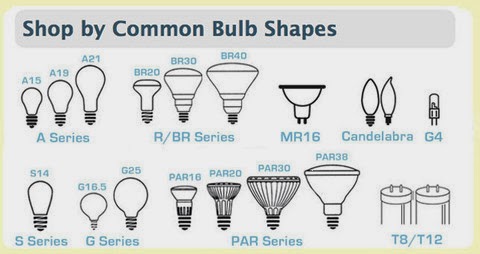When our house got bulbed, the electricians installed 50-watt halogens that emit 900 lumens (see photos above; wished they had talked to us before putting those babies in...). Since we really really want LEDs (energy efficiency and all), the next question was: which ones? Cause there are many, many, many to choose from...
The first challenge was figuring out what type of bulb we had/needed. This handy chart Rosetta stones bulb nomenclature:
So based on the bulb we have, we have a PAR series (a PAR30 to be exact). As it turns out PAR30s come in different sizes, namely length and diameter, so the next step was to measure an existing bulb to see what our target was.
We also measured the diameter of the hole in the can to see what our maximum allowable space is (although I wouldn't push getting a bulb to the edge given heat dissipation concerns...).
The next challenge was figuring out what temperature of light we wanted. Interestingly enough, this is somewhat cultural in that it depends on what you are used to. Because we Americans have grown up with Tom Edison's incandescents, we favor warmer light (cooler temperatures; higher temps correspond with whiter light; think of "white hot" and hotter = whiter). In contrast, Europeans embraced fluorescents which emit a cooler (higher temperature) light, which better mimics daylight. At first I thought we would want a more accurate representation of daylight, but holy-moly does it look like an operating room with light like that. We're 'mericans, dammit! We like our light warm and cuddly: give me 3000 degrees Kelvin or give me death!
The next challenge was finding bulbs that (1) fit, (2) didn't cost an arm and a leg, and (3) rocked the aesthetics. After a bit of trial and error on all fronts (thank you, Lowes, for liberal return policies!), we discovered our bulb: the Utilitech Pro PAR30 Flood. Utilitech, a Lowes brand, is highly rated by Consumer Reports (as are almost all LEDs) and comes in at $25 a pop (the price just dropped by five bucks last week). It's a wee bit longer than the original halogens, but not enough to look weird. And the bulb is gorgeous! It looks a little futuristic and has an orangey center (some filter, I reckon, to warm up the light). They've just upgraded the light to where it emits a nice consistent wash of warm light (the previous version, when used as a spot on some art we had, had orangish spots at the edge of the emitted light cone; drove the bride crazy...). They use 15 watts (compared to the 50 of the halogens and the 90 of an equivalent incandescent) and emit 790 lumens (less than the 900 of the halogens, but it seems to be enough).
What is was...
What it is now!
The light is a hint whiter than the halogens, but not by much. I think we'll be happy with them (we'd better be: we'll be living with them for the next 25 years!).
Halogen on the left; LCD on the right.
Amidst our early experiments, we mistakenly purchased some BR30s. This particular BR30 is also made by Utilitech (and comes it at a sweet twenty bucks a piece). It has a cooler light and, given it's shape, spreads the light quite a bit more. They didn't work in the downstairs cans (stuck out too far and thus appeared too bright), but they worked great in the two, deeper cans upstairs. Not as interesting aesthetically as the PAR30 above, but they gets the job done.
The plan is to buy four bulbs a month until the house is fully LEDed. The PAR30s we're using inside are not designed for outdoor use, so we'll have to find a different bulb for the outside cans. Perhaps the fully enclosed BR30s shown above.














This comment has been removed by a blog administrator.
ReplyDelete